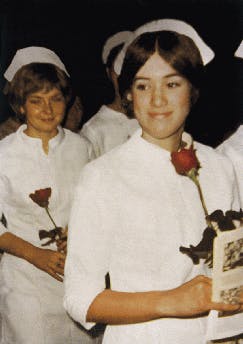To understand prospects for a bright future, take a look back at our humble beginnings
Lynne Hollister Slim, RDH, MS
As a graduate of Fones School of Dental Hygiene (University of Bridgeport, Connecticut) in 1972, I was privy to historical archives and artifacts that confirm our humble beginnings as a profession. Fones was the first school of dental hygiene in the United States, graduating its first class in 1914. Dental hygienists, at that time, were called "women assistants." Their duties were limited to the removal of deposits and stains from the teeth. The Connecticut Dental Law permitted hygienists to work under general supervision in a private dental office or in any private/public institution.
Students of the early 1970s at Fones wore white polyester dresses or pant suits with white, full-length lab coats and caps decorated with 3/4-inch purple velvet ribbon. Face makeup was very limited, and I don`t think jewelry of any kind was permitted. I remember having to shop for white clinic shoes - the kind that required polishing with white creme polish. We purchased white stockings in uniform stores. Some of us who were very vain, like myself, would wear a thin line of eyeliner, or a bit of mascara, but that would be about it.
Clinical instrumentation skills were limited to hand instruments, and polishing was taught using a belt-driven handpiece for rubber-cup polishing or a porte polisher. My dark brown hair, which was usually pulled back into a pony tail and then neatly tucked under my cap, was always getting caught in the belts that made the handpiece run. I am left-handed, so the entire apparatus including the belts was always dangerously close to my scalp.
We were forever mixing pumice and water for polishing heavy extrinsic stain with rubber cups. I distinctly remember feeling very clever by mixing mouthwash with pumice instead, producing a better-tasting concoction.
The year I graduated from Fones, the coveted award for excellence in dental hygiene was the "Golden Scaler" award. This award was presented to the graduating student/clinician whose instrumentation skills were most admired by her instructors. In case you are wondering, I did not win this award - but the receipt of a class pin and a long-stemmed rose made up for it in the long run.
We were a proud, ambitious, and committed bunch of young women with high aspirations and lofty ideals. Our externship program at a nearby Bridgeport City hospital included memorable lessons in sharpening hand instruments by a very capable and caring instructor, Mabel McCarthy, who at the time was in her 90s. Mrs. McCarthy graduated from the very first class of dental hygienists at Fones.
Our dental class was also privileged to treat school-age children at a dental clinic in the basement of a Bridgeport City public school. We were reminded of our humble beginnings in the early 1900s when hygienists assembled portable chairs in school corridors and performed prophylaxes using sickle-shaped instruments, orange wood sticks, pumice, and various other rudimentary supplies and equipment.
Now, some 20 years later, I am practicing as a periodontal co-therapist in a high quality and progressive periodontal specialty practice. My entire approach to patient care has been altered and updated, thanks to new technologies, research advances, continuing education, and a more advanced dental hygiene knowledge base. Many of today?s clinicians, including myself, use a variety of ultrasonic instruments, an air-polishing device, state-of-the-art periodontal charting software, and work one-on-one with a dental assistant.
Granted, our profession is still struggling for autonomy. Even now, we are experiencing reversals in state practice acts, as well as the regrettable and deplorable attempts to lower education standards. It seems that for every step forward, we take two steps back.
Backlash in any movement is inevitable, I believe, and must be dealt with in the following way. With positive thinking and a healthy dose of optimism, we can chart a new course, a new wave, so to speak. We must continue in our pursuit of dental hygiene excellence, just like the students at Fones and elsewhere around the globe. It has been the simple symbols, like special velvet ribbons on caps, Ogolden scalerO awards, class pins or simple single-stemmed roses that have helped us define ourselves and our professions.
Our future will be better than our past.
Lynne Hollister Slim, RDH, MS, (neé Lynne Patricia Hollister) currently lives in Douglasville, Ga. She has previously written for several dental hygiene publications, including RDH (October 1994) and has won several journalism awards in dental hygiene.
The author, as photographed during her 1972 graduation ceremony.

